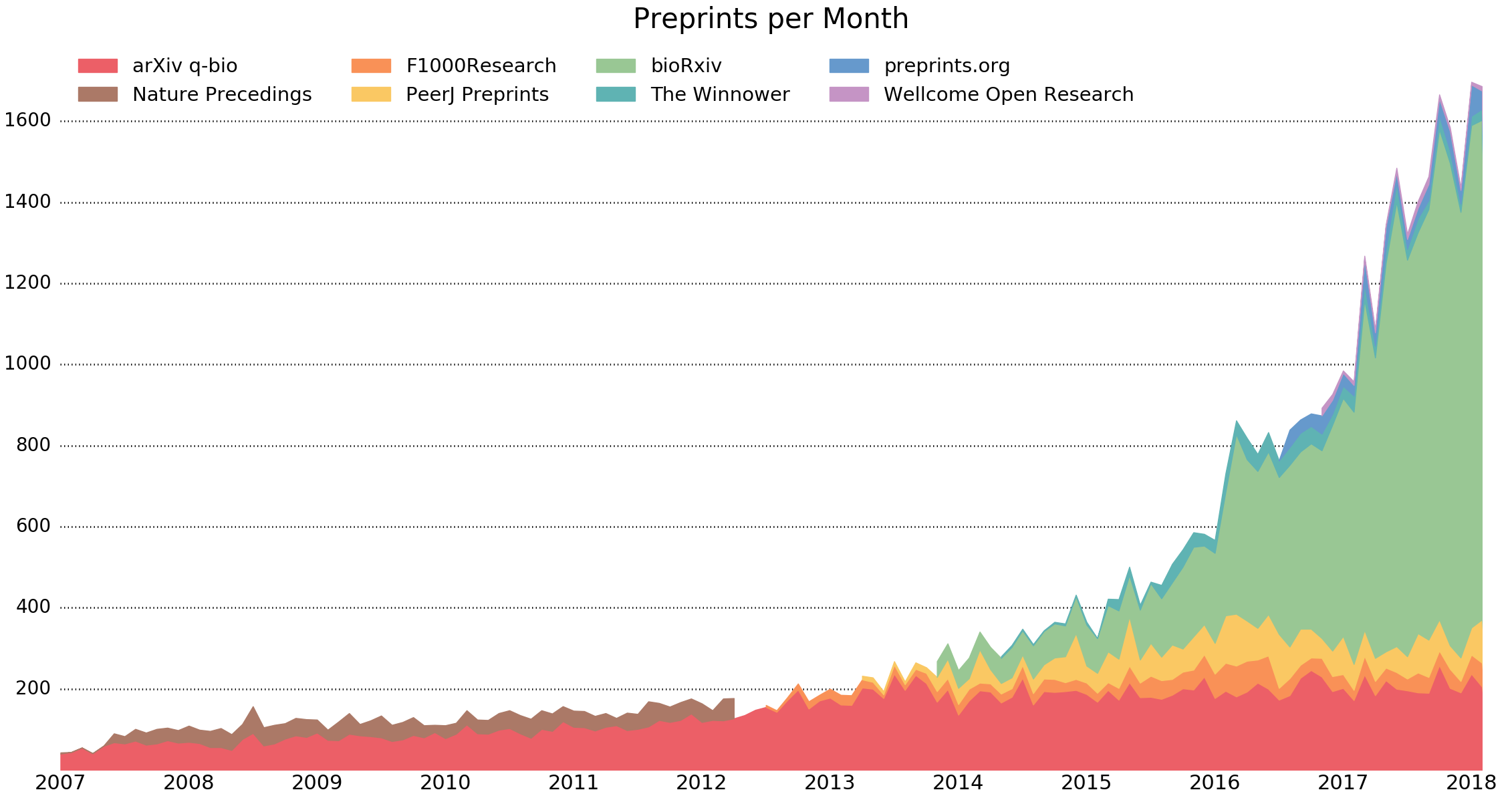The growing popularity of preprints: shifting control?
 By Evan Sterling
By Evan Sterling
Preprints have gotten really popular in life sciences research in the past few years:
This tweet by a biomedical researcher struck a chord. But what exactly are preprints, why are they becoming so popular, and what issues does this raise?
Preprints are a mostly-finalized draft version of an academic article which is publicly shared on the internet, before being peer-reviewed. They have been around about as long as scientific journals have been around, and have had a home on the internet since the early 1990s when the arXiV was founded at Cornell University for physicists and mathematicians. Preprints have mostly replaced peer-reviewed journals as the way physicists communicate – see Google Scholar’s ‘journal’ rankings which show four of the top five journals are actually subsections of arXiV!
Appeal
What is the appeal? The biggest part of it is taking some control back from journals and getting your work out there quickly – to get feedback and to promote your research. The traditional submission and review process usually takes 1-2 years to play out, which is particularly frustrating in a fast-developing area like genetics or medicine. One researcher, Christophe Dessimoz, describes a four-year wait for publication of his results and how it increased his support for preprints.
A paper shared earlier in the process can receive feedback, generate buzz, and lead to journal invitations before ever appearing in "print". An example is this preprint on ribosomes posted to BioRxiv in 2014 by Nikolai Slavov, which led to active discussion and a research job offer before the final version of the paper even appeared, as he described to Science later.
Growth
In the life sciences, preprints were held back by worries about being ‘scooped’ or plagiarised, and about whether journals would even accept an article previously released as a preprint. However, journals have recently liberalised their policies and new venues have opened up including F1000, Peerj-Preprints and BioRxiv. The National Institutes of Health, one of the biggest funders of life sciences research in the United States, has announced they will take preprints into consideration in their grant reviews.
This chart from prepubmed.org by Jordan Anaya shows the huge growth in preprints that resulted, mostly via BioRxiv. Caveat though: these still only represent a small fraction of all life sciences papers; this article from WIRED last year put the figure at about 1%.

Effects and Risks
This trend, if it continues, will have definite effects on the life sciences community:
- For young researchers, being able to cite preprints will help bolster their CVs in the early years when they may only have one or two published papers. But if they continue to grow in popularity, the unintended effect may be more pressure to publish quickly and publish peacemeal, which could increase the already high stress on them, as biology professor Terry McGlynn worries.
- With this potential pressure to publish prematurely, there is also a risk of unvalidated, erroneous health and medical research getting out of the academic sphere with harmful impacts. But there are errors in peer-reviewed work too. Currently almost no preprint servers accept clinical medicine papers.
- Another unintended risk is that the benefits of preprints rely on a circle or community of peers willing to give feedback on an ad-hoc basis – and this may not be true for researchers who aren't well-connected. Biostatician Jeff Leek says there is no incentive to peer review under such a model, and has done economic modelling to analyze the incentives.
So what will the result of the preprint trend be? One possibility is that they cause authors to forgo journal publication entirely, as happens frequently now in physics. But this doesn’t seem to be as likely in life sciences - there is a general desire not to throw the baby out with the bathwater.
Another possible scenario is a blending of the arXiV model with the traditional model, in which there is a limited pre-posting review, followed by a more rigorous review of some sort later. Forums like F1000 are already moving towards this model - F1000 typesets, adds metadata, and checks for plagiarism and ethical red flags. And the ASAPBio collective wants to establish a central federated server that will enforce minimum quality standards to meet the demands of funders. Sounds a little like a journal, no?

